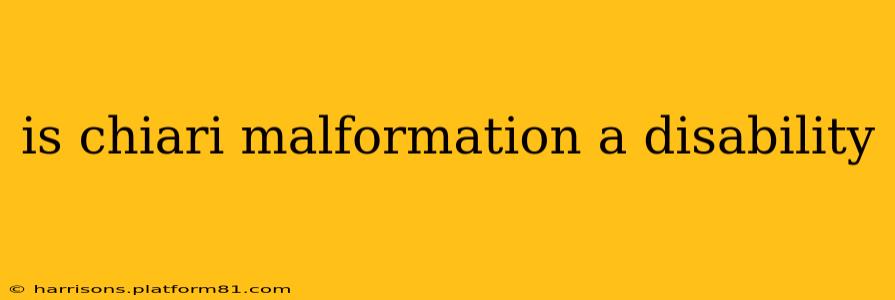Chiari malformation is a structural defect in the cerebellum, the part of the brain responsible for coordination and balance. Its impact varies greatly from person to person, making the question of whether it constitutes a disability a complex one. While it isn't automatically classified as a disability, it can certainly lead to significant disabilities in many individuals. This post will explore this complexity, addressing common questions and providing a nuanced perspective.
What is Chiari Malformation?
Chiari malformation refers to a range of conditions where the cerebellum and brainstem are pushed down into the spinal canal. This can cause pressure on the brain and spinal cord, leading to a wide array of symptoms. The severity of the malformation and its resulting symptoms are key factors in determining its impact on an individual's life.
Can Chiari Malformation Qualify for Disability Benefits?
This is a crucial question for many individuals affected by Chiari. Whether or not Chiari malformation qualifies for disability benefits (such as Social Security Disability Insurance or Supplemental Security Income in the US, or equivalent programs in other countries) depends heavily on the severity of symptoms and their impact on the individual's ability to work.
The determination is made on a case-by-case basis, focusing on the individual's functional limitations. A person with mild Chiari malformation experiencing minimal symptoms might not qualify, whereas someone with severe symptoms significantly impacting their ability to perform daily tasks or maintain employment likely would. Medical documentation from a qualified neurologist is crucial in this process.
What are the Common Symptoms of Chiari Malformation That Could Lead to Disability?
The symptoms of Chiari malformation vary widely but can include:
- Severe Headaches: Intense and persistent headaches can severely interfere with daily life and work.
- Balance Problems: Difficulty with coordination and balance can make even simple tasks challenging and dangerous.
- Numbness and Weakness: This can affect the limbs, leading to difficulties with fine motor skills and physical activities.
- Cognitive Difficulties: Some individuals experience cognitive impairments such as problems with memory, concentration, and processing speed.
- Vision Problems: Blurred vision or double vision can greatly impede work and daily tasks.
- Difficulty Swallowing (Dysphagia): This can lead to malnutrition and other health complications.
- Chronic Pain: This can range from mild discomfort to debilitating pain.
The presence and severity of these symptoms are critical in determining the extent of disability.
How is the Disability Determined for Chiari Malformation?
Disability determination agencies, such as the Social Security Administration, assess disability based on medical evidence, functional limitations, and the individual's ability to engage in substantial gainful activity (SGA). They consider:
- Medical records: Comprehensive medical history, including imaging studies (MRI), neurological examinations, and treatment records.
- Functional limitations: A detailed assessment of how the symptoms affect daily activities, including work-related tasks.
- Vocational assessment: An evaluation to determine if the individual can perform any other type of work given their limitations.
The process can be complex and time-consuming, often requiring multiple appeals. Legal assistance may be necessary for navigating this process.
Does Having Chiari Malformation Automatically Mean You Are Disabled?
No. Chiari malformation itself is not an automatic qualifier for disability. The extent of disability is determined by the impact of the condition's symptoms on an individual's ability to function in daily life and maintain employment.
What type of support is available for individuals with Chiari Malformation?
Beyond disability benefits, individuals with Chiari malformation can benefit from various support systems:
- Medical care: Regular monitoring and treatment by a neurologist or neurosurgeon.
- Physical therapy: To improve balance, coordination, and strength.
- Occupational therapy: To adapt daily tasks to accommodate limitations.
- Support groups: Connecting with others facing similar challenges can be invaluable.
In conclusion, while Chiari malformation is not automatically a disability, its impact on daily life can be significant and lead to a disability classification depending on individual circumstances. Careful assessment of symptoms and their functional implications is crucial in determining eligibility for disability benefits and accessing appropriate support services. Seeking professional medical advice and guidance is highly recommended.
